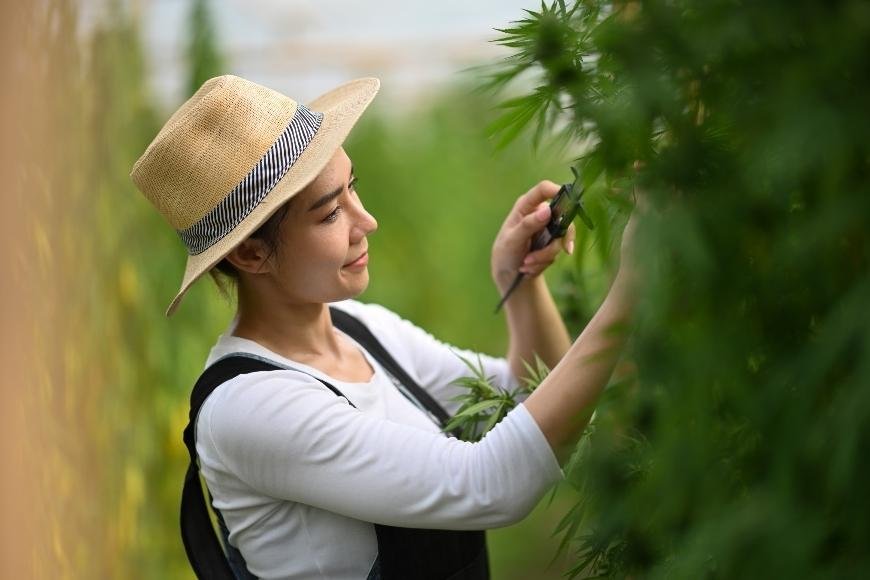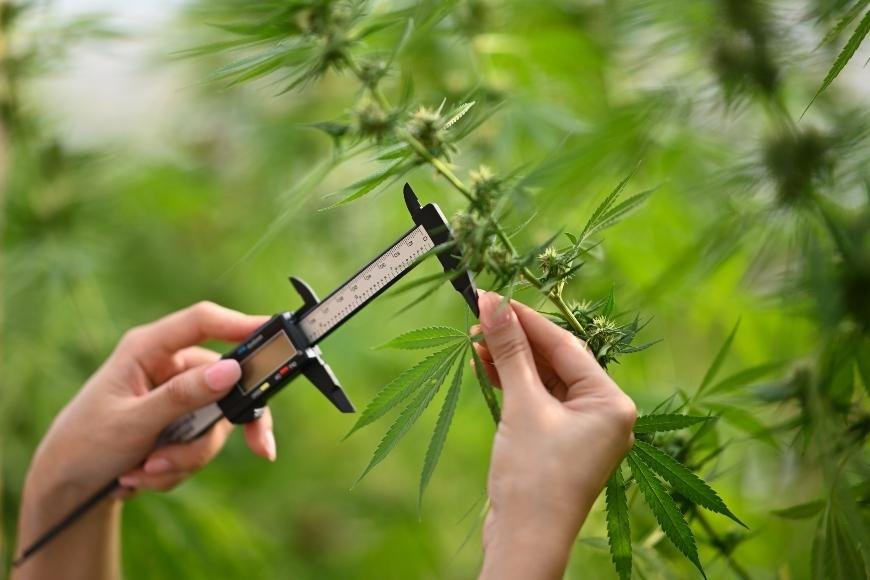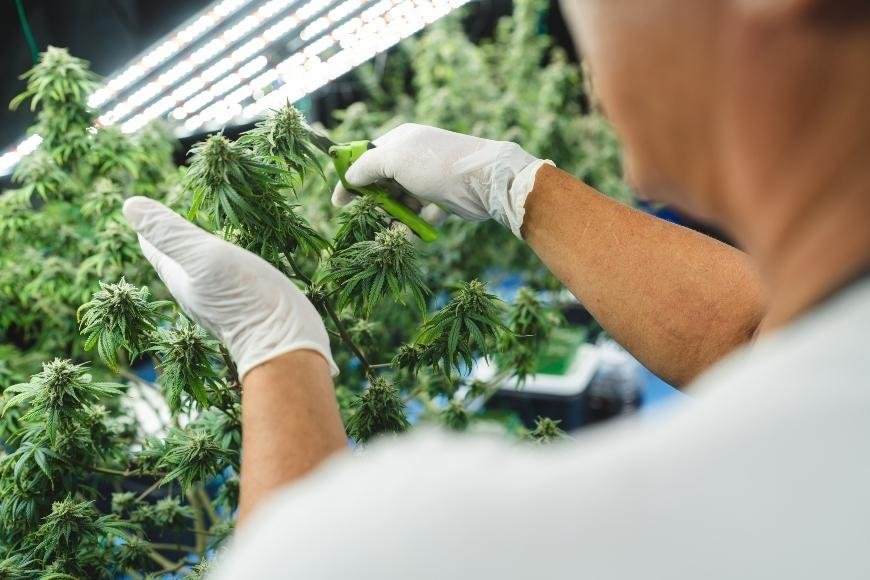Knowing When to Harvest Cannabis Plants
Optimizing the harvest time of cannabis plants is critical for potency and yield. Learn when and how to harvest cannabis for the best results.

Knowing when to harvest cannabis plants is an essential skill for any cultivator seeking optimal results. To ensure successful cannabis cultivation, this post will explore the various factors and methods that can help you pinpoint when to harvest your marijuana plants for optimal results. By understanding these techniques, you'll be able to maximize your plant's cannabinoids and overall potency.
We will begin by discussing how monitoring trichomes for harvest readiness plays a crucial role in determining the perfect moment to reap your cannabis buds. Next, we'll explore observing physical signs of maturity as another reliable indicator of ripe buds. Additionally, addressing nutrient deficiencies and dealing with pest infestations are vital aspects of cannabis cultivation that should not be overlooked.
Lastly, we will touch upon different harvesting techniques that can ensure a successful yield while preserving the quality of your harvested weed. Stay tuned as we guide you through the intricacies of knowing when to harvest cannabis plants like a pro.
Table of Contents:
- Observing Physical Signs of Maturity
- Monitoring Trichomes for Harvest Readiness
- Addressing Nutrient Deficiencies
- Dealing with Pest Infestations
- Harvesting Techniques
- FAQs in Relation to Knowing When to Harvest Cannabis Plants
- Conclusion
Observing Physical Signs of Maturity
When it comes to harvesting cannabis, physical signs of maturity are a key indicator that the plant is ready. The buds should be inspected for changes in color and texture. Trichomes, or resin glands, can also indicate when the plant is ready for harvest.
The most common sign of maturity in cannabis plants is a change in color from green to purple or blue hues. As the plant matures, its pistils will darken and transition to shades of orange or red. This change usually occurs two weeks before harvest time but may vary depending on strain and growing conditions.
Another important sign of maturity is trichome development which can be observed with a magnifying glass or microscope if necessary. Trichomes appear as tiny crystals that cover the leaves and buds of mature cannabis plants – they look like little hairs under magnification. When these trichomes turn from clear to cloudy white, it’s an indication that the cannabinoids have reached their peak potency levels and the plant is ready for harvest.
Texture can also provide clues about when a marijuana crop has matured enough for harvesting purposes. Buds should feel firm yet pliable; too soft means over-ripe while too hard indicates under-maturity (in both cases yields will suffer). It’s best to err on the side of caution by waiting until at least 70% of trichomes have turned cloudy before cutting down your crop.
Finally, smell can be used as another way to gauge ripeness. Experienced growers know exactly what terpenes (aromatic compounds) smell like when ripe, providing them with another tool for determining optimal timing for harvesting their rewards. Combining all these factors together gives an accurate picture of when marijuana plants are truly “ready” according to each individual strain's characteristics - so it is important to pay attention and not rush things if the best quality product is desired.
Growers can keep an eye out for alterations in hue and texture to decide when their cannabis crops are ready for gathering. Now that we have discussed observing physical signs of maturity, let's move on to examining how trichomes can be used to monitor harvest readiness.
Monitoring Trichomes for Harvest Readiness
Trichomes are small resin glands that produce cannabinoids and terpenes – the compounds responsible for giving marijuana its unique flavor and effects. Trichomes, the minuscule resin glands that generate cannabinoids and terpenes, are a vital factor in determining when to harvest cannabis plants.
The first step in monitoring trichomes is to look at them under magnification. A magnifier or microscope can be used to get a closer look at the trichome heads, permitting you to observe their clarity and hue. When they’re mature enough for harvest, they should appear clear or milky white in color with some amber hues mixed in depending on strain genetics. If the majority of your trichomes are still cloudy or opaque then your plant isn’t quite ready yet.
Another way to monitor trichome maturity is by feeling them between two fingers (it helps if you wear gloves). Mature trichomes should feel sticky and slightly oily while immature ones won’t have this same texture. It may also help to rub two fingers together over different parts of the bud – if there’s an abundance of sticky residue then chances are good that it's time for harvest.
It's important not to wait too long before harvesting as well; otherwise, THC levels will start dropping off due to degradation from exposure to light and air as well as increased oxidation caused by heat buildup inside buds during flowering stage growth cycles. If left unchecked this could lead to weaker effects when consuming your flower so make sure you keep an eye on those little guys.
Ultimately, one method to decide if your cannabis plants are ripe for picking is examining their pistils (the little hairs on the buds). Once around 50-70% have darkened/browned then you know it's time; just don't forget about all those other factors mentioned above either since timing can vary based on strain genetics as well.
Monitoring trichomes for harvest readiness is a crucial step in harvesting cannabis plants as it can determine the potency of your final product. Addressing any nutrient lacks is key to ensuring your plants acquire all the essential nutrients they need for optimal bud production.

Addressing Nutrient Deficiencies
Cultivating cannabis can be challenging, with nutrient deficiencies being a particularly irksome issue for growers to contend with. Fortunately, these issues are usually easy to identify and treat if caught early enough. During the flowering stage, it is common for cannabis to suffer from a lack of nitrogen (N), phosphorus (P), potassium (K) and magnesium (Mg).
When nitrogen is lacking in the soil or grow medium, plants may display signs of deficiency such as yellowing or browning leaves. When there’s not enough nitrogen available in the soil or grow medium, leaves may turn yellow or brown as a sign of deficiency. To fix this issue, add fertilizer that contains more nitrogen such as bat guano or fish emulsion.
Phosphorus Deficiency:
Phosphorus is important for root development and bud production so when there isn’t enough available in the soil it can cause stunted growth or slow down flower formation. To address this problem you should use a fertilizer that has higher levels of phosphorus like bone meal or rock phosphate.
Potassium Deficiency:
Potassium helps strengthen stems and increase yields so without adequate amounts your plants will become weak and have fewer flowers than normal. The best way to remedy this situation is by using fertilizers that contain high levels of potassium like kelp meal or wood ash from fruit trees like apple trees.
A lack of magnesium can affect photosynthesis, resulting in stunted growth and reduced yields. Epsom salts are great for providing extra magnesium but you could also try adding dolomite lime, which contains both calcium carbonate and magnesium carbonate into your soil mix instead.
Addressing nutrient deficiencies is an important step in ensuring a successful cannabis harvest. Monitoring the plants vigilantly is essential to thwart any potential pest infestations and preserve a healthy harvest.
Dealing with Pest Infestations
Pest infestations can be a major problem for recreational growers of cannabis. It is important to be able to identify and address these issues quickly in order to maintain the health of your plants. Aphids, spider mites, thrips, whiteflies, caterpillars and root maggots can be seen in cannabis during its flowering stage - something that must be addressed quickly to keep plants healthy.
Harvesting Techniques
Harvesting methods differ depending on the type of crop being reaped. For cannabis, one popular method is hand-trimming. Hand-trimming involves using scissors or a knife to carefully remove buds from the plant and trim off excess foliage and stems. This technique can be time consuming but produces an aesthetically pleasing end product that appeals to consumers who prefer top quality bud. Additionally, it allows for more control over what gets trimmed away from the bud, allowing growers to customize their harvest according to personal preference.
Another harvesting technique used by many cannabis growers is machine trimming. Machine trimmers are automated machines that use rotating blades to quickly cut through buds with precision and accuracy while minimizing waste material such as leaves and stems. While this method may not produce quite as high quality of a finished product as hand-trimming, it does save time and effort which makes it attractive for larger scale operations where speed is important.

FAQs in Relation to Knowing When to Harvest Cannabis Plants
How do you know when to harvest plants?
Gathering crops demands carefulness and familiarity with the vegetation's lifecycle. Generally, harvesting should be done when the flowers have fully developed and matured, as this will provide maximum potency. Visual cues such as color change in trichomes can also indicate harvest time. Additionally, some strains may require specific environmental conditions before they are ready for harvest. Careful observation and research into your strain’s needs is essential to ensure you get the best results from your crop.
How soon is too soon to harvest cannabis?
Harvesting cannabis too soon can be detrimental to the quality of your product. Generally, growers wait until the trichomes on the buds have turned from clear to milky white or amber in color before harvesting. The best time to harvest is when most of the trichomes are cloudy and a few are still clear, as this indicates that THC levels have peaked but not yet started degrading. Harvesting at this stage will ensure you get maximum potency and flavor from your plants.
Conclusion
Harvesting cannabis plants is a delicate process that requires careful observation and timing. Knowing when to harvest can be the difference between an average product and one of superior quality. By monitoring trichomes, observing physical signs of maturity, addressing nutrient deficiencies, dealing with pest infestations and utilizing different harvesting techniques appropriately you will be well on your way to producing high-quality cannabis products. With the right knowledge in hand, knowing when to harvest cannabis plants becomes much easier.






















































































































